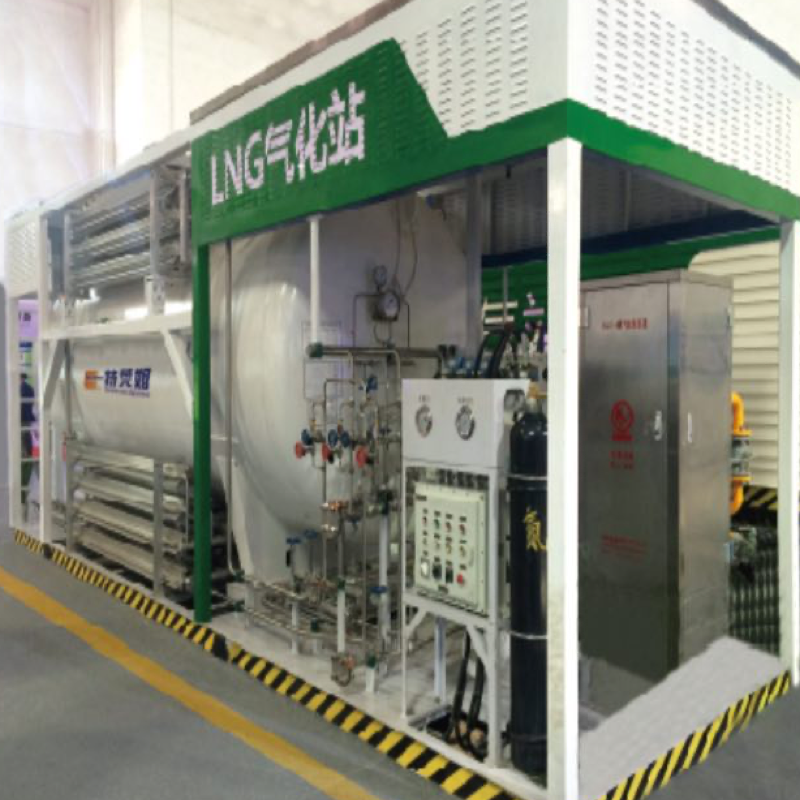close
Choose Your Site
Global
Social Media



| Availability: | |
|---|---|
| Quantity: | |











The LNG Vaporizing Station Skid Mounted Equipment integrates vaporization, pressurization, and safety systems into a single, transportable unit. Designed for rapid deployment, this skid-mounted solution includes core components such as AAVs or IFVs (based on capacity), booster pumps, pressure regulators, and PLC-based control panels. It enables turnkey LNG-to-gas conversion, eliminating the need for on-site construction of separate systems .
Rapid Installation
Factory-assembled skids reduce on-site installation time by 60% (from 8–12 weeks to 2–4 weeks), requiring only utility connections (power, LNG inlet, gas outlet) and commissioning.
Suitable for temporary setups (e.g., disaster relief camps) or permanent installations, including mobile emergency stations and retrofitted gas grids in urban areas.
High Safety Standards
Equipped with double-wall pipes (inner stainless steel, outer carbon steel) and infrared gas leak detection sensors (response time <1 second) to prevent LNG spills and gas leaks.
Automatic pressure relief valves (set at 110% of operating pressure) and flame arrestors (with mesh size ≤0.2 mm) ensure compliance with ISO 13623 (pipeline safety) and NFPA 59A (LNG facility standards).
Flexible Configuration
Customizable to handle LNG flow rates from 1,000 to 50,000 Nm³/h, with options for redundancy (dual vaporizers, pumps) and scalability (adding skid modules for increased capacity).
Mobile Fueling Stations: Deployed at construction sites, mining operations, or temporary events (e.g., music festivals) to refuel LNG-powered vehicles.
Small-Scale Power Plants: Provides gas for generators (5–50 MW) in off-grid locations, such as remote islands or rural communities without access to natural gas pipelines.
Retail Gas Stations: Integrates with existing infrastructure for LNG vehicle fueling, offering fast refueling (5–10 minutes per truck) via high-pressure dispensers.
Q: How much space does a skid-mounted station require?
A: A standard skid measures 6–12 meters in length, 2.5 meters in width, and 3–4 meters in height, requiring a concrete foundation of 10–25 m²—suitable for compact sites like urban industrial zones or highway rest stops.
Q: Can the skid operate in extreme climates?
A: Yes. Skids are designed for -40°C to +50°C environments: cold-climate models include insulation (PU foam, thickness 50–100 mm) and heater strips, while hot-climate versions add ventilation fans and heat shields for electronics.
Q: What certifications does the skid comply with?
A: Compliance with ASME BPVC Section VIII (pressure vessel design), EN 13480 (pipeline systems), and ATEX/IECEx (hazardous area classification) ensures global acceptability in both hazardous and non-hazardous zones.

The LNG Vaporizing Station Skid Mounted Equipment integrates vaporization, pressurization, and safety systems into a single, transportable unit. Designed for rapid deployment, this skid-mounted solution includes core components such as AAVs or IFVs (based on capacity), booster pumps, pressure regulators, and PLC-based control panels. It enables turnkey LNG-to-gas conversion, eliminating the need for on-site construction of separate systems .
Rapid Installation
Factory-assembled skids reduce on-site installation time by 60% (from 8–12 weeks to 2–4 weeks), requiring only utility connections (power, LNG inlet, gas outlet) and commissioning.
Suitable for temporary setups (e.g., disaster relief camps) or permanent installations, including mobile emergency stations and retrofitted gas grids in urban areas.
High Safety Standards
Equipped with double-wall pipes (inner stainless steel, outer carbon steel) and infrared gas leak detection sensors (response time <1 second) to prevent LNG spills and gas leaks.
Automatic pressure relief valves (set at 110% of operating pressure) and flame arrestors (with mesh size ≤0.2 mm) ensure compliance with ISO 13623 (pipeline safety) and NFPA 59A (LNG facility standards).
Flexible Configuration
Customizable to handle LNG flow rates from 1,000 to 50,000 Nm³/h, with options for redundancy (dual vaporizers, pumps) and scalability (adding skid modules for increased capacity).
Mobile Fueling Stations: Deployed at construction sites, mining operations, or temporary events (e.g., music festivals) to refuel LNG-powered vehicles.
Small-Scale Power Plants: Provides gas for generators (5–50 MW) in off-grid locations, such as remote islands or rural communities without access to natural gas pipelines.
Retail Gas Stations: Integrates with existing infrastructure for LNG vehicle fueling, offering fast refueling (5–10 minutes per truck) via high-pressure dispensers.
Q: How much space does a skid-mounted station require?
A: A standard skid measures 6–12 meters in length, 2.5 meters in width, and 3–4 meters in height, requiring a concrete foundation of 10–25 m²—suitable for compact sites like urban industrial zones or highway rest stops.
Q: Can the skid operate in extreme climates?
A: Yes. Skids are designed for -40°C to +50°C environments: cold-climate models include insulation (PU foam, thickness 50–100 mm) and heater strips, while hot-climate versions add ventilation fans and heat shields for electronics.
Q: What certifications does the skid comply with?
A: Compliance with ASME BPVC Section VIII (pressure vessel design), EN 13480 (pipeline systems), and ATEX/IECEx (hazardous area classification) ensures global acceptability in both hazardous and non-hazardous zones.
